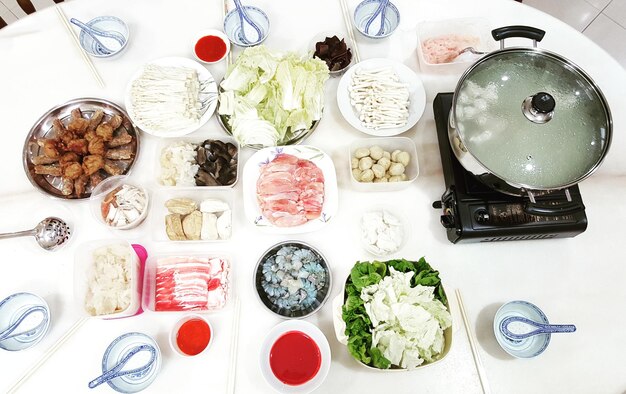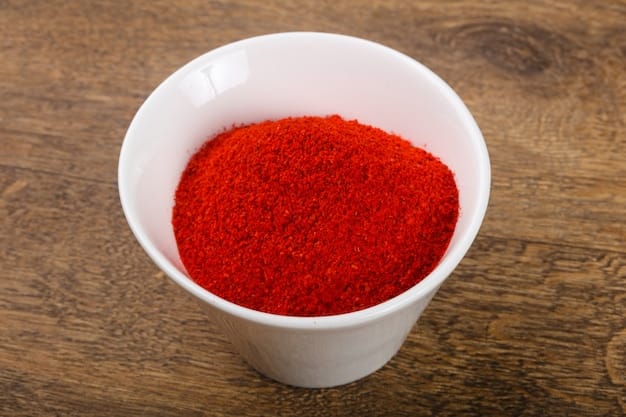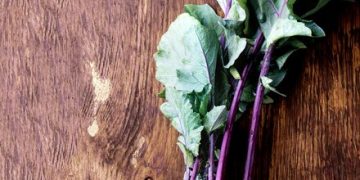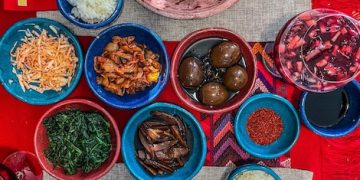The Art of Kimchi Making: A Home Cook’s Guide for the US

The Art of Kimchi Making: A Step-by-Step Guide for US Home Cooks explores the history, health benefits, and the essential steps needed to make authentic and delicious kimchi at home, tailored for the American kitchen.
Embark on a culinary adventure and discover the art of kimchi making: a step-by-step guide for US home cooks. This traditional Korean staple, known for its vibrant flavors and health benefits, is now easier than ever to create in your own kitchen.
Unveiling the Magic of Kimchi
Kimchi, a cornerstone of Korean cuisine, is infinitely more than fermented cabbage. It’s a flavorful blend of tradition, culture, and gut-friendly goodness. Understanding its origins and health benefits can deepen your appreciation for this culinary art.
A Brief History of Kimchi
Kimchi has a history dating back thousands of years, evolving from simple salted vegetables to the complex, spicy dish we know today. Originally, it was a way to preserve vegetables during the harsh Korean winters.
Health Benefits of Kimchi
Beyond its delicious taste, kimchi is packed with probiotics, vitamins, and antioxidants. These contribute to gut health, boost the immune system, and may even have anti-inflammatory properties.
- Probiotics: Supports a healthy gut microbiome.
- Vitamins: Rich in vitamins A, B, and C.
- Antioxidants: Helps combat oxidative stress.
Kimchi isn’t just food; it’s a celebration of history, health, and vibrant flavors passed down through generations.
Gathering Your Kimchi Arsenal: Essential Ingredients
The heart of great kimchi lies in the freshness and quality of its ingredients. Gathering the right components is half the battle won. Ensure you have everything you need before beginning!
Core Vegetables: Napa Cabbage and Radish
Napa cabbage forms the base of most kimchi recipes, offering a mild, slightly sweet flavor. Korean radish (mu) adds a crisp texture and subtle sharpness.
The Flavor Brigade: Aromatics and Spices
Garlic, ginger, scallions, and gochugaru (Korean chili powder) provide the signature kimchi flavor. Fish sauce or salted shrimp adds umami depth.

- Gochugaru: Use Korean chili powder for authentic flavor and color.
- Fish Sauce: Adds essential umami; vegetarian alternatives exist.
- Garlic & Ginger: Freshly minced for maximum aromatic impact.
Selecting high-quality ingredients is paramount. Fresh vegetables and properly sourced spices ensure the best possible flavor in your homemade kimchi.
The Art of Brining: Setting the Stage for Fermentation
Brining the Napa cabbage is an indispensable early step in the kimchi-making journey. This process not only softens the cabbage but also preps it for optimal fermentation.
Proper brining helps remove excess moisture from the cabbage, allowing the flavors to penetrate more effectively and creating an environment conducive for beneficial bacteria to thrive.
Prepping the Cabbage
Start by quartering the Napa cabbage, then generously salting each layer. Allow it to sit for a couple of hours, flipping occasionally to ensure even salting.
Rinsing the cabbage after brining is crucial to remove excess salt. This step prevents the kimchi from becoming overly salty and allows the flavors to be more balanced.
Well-brined cabbage is the foundation of great kimchi, promoting both the right texture and the perfect flavor development during fermentation.
Crafting the Kimchi Paste: The Soul of the Dish
The kimchi paste is where the magic truly happens. It’s a complex blend of flavors that will transform the humble cabbage into a culinary masterpiece.
Different regions and families have their own unique recipes for kimchi paste, reflecting personal preferences and available ingredients.
Blending the Aromatics
Combine garlic, ginger, scallions, and gochugaru in a bowl. This aromatic base delivers the signature kimchi spice and fragrance.
Adding Umami: Fish Sauce or Alternatives
Incorporate fish sauce or salted shrimp for a savory depth; use a vegetarian alternative like kelp broth for a vegan kimchi.

- Adjusting Spice Levels: Add more or less gochugaru to suit your preferred heat.
- Achieving the Right Consistency: The paste should be thick enough to coat the cabbage evenly.
Experimenting with different ratios and ingredients can allow you to create a kimchi paste that perfectly reflects your taste preferences.
The Assembly Line: Marinating and Packing
Marinating and packing are key steps to ensure the uniformity and effectiveness of the fermentation process. Every leaf should be coated in the flavorful paste!
Properly marinating and packing the kimchi ensures that all the ingredients are evenly distributed and ready for fermentation.
Coating the Cabbage
Thoroughly coat each cabbage leaf with the kimchi paste, working it into every nook and cranny. This ensures even flavor distribution.
Packing the Kimchi
Tightly pack the marinated cabbage into a clean glass jar or container. Leave some headspace for expansion during fermentation.
- Avoiding Air Pockets: Ensure there are no air pockets to prevent mold growth.
- Selecting the Right Container: Glass jars or fermentation-specific containers are ideal.
Attentiveness to detail during the marinating and packing phases can significantly impact the quality and shelf life of your homemade kimchi.
The Waiting Game: Fermentation and Flavor Development
Fermentation is the heart and soul of kimchi making. It transforms raw ingredients into a tangy, spicy, and probiotic-rich delicacy. Patience is key!
The fermentation process not only imparts unique flavors but also boosts the nutritional value of kimchi, creating a wealth of probiotics.
Room Temperature Fermentation
Allow the kimchi to ferment at room temperature for 1-3 days, depending on your taste preference and the ambient temperature.
Refrigeration and Aging
Once the kimchi reaches your desired level of sourness, transfer it to the refrigerator to slow down the fermentation process.
- Monitoring Fermentation: Check daily for bubbles and the development of sourness.
- Adjusting Fermentation Time: Warmer temperatures speed up fermentation, while cooler temperatures slow it down.
Mastering the art of fermentation requires a delicate balance of temperature, time, and personal taste. With practice, you’ll learn to identify the perfect moment to refrigerate your kimchi.
Serving and Savoring: Enjoying Your Homemade Kimchi
Your homemade kimchi is ready! Now, it’s time to explore the myriad ways to enjoy this versatile and flavorful dish.
Kimchi can be enjoyed in countless ways, from a simple side dish to a flavorful ingredient in more complex recipes.
Kimchi as a Side Dish
Serve kimchi as a traditional accompaniment to rice, grilled meats, or Korean barbecue.
Kimchi in Recipes
Incorporate kimchi into stews, fried rice, pancakes, and even grilled cheese sandwiches for a burst of flavor.
- Kimchi Stew (Kimchi Jjigae): A comforting and spicy stew.
- Kimchi Fried Rice (Kimchi Bokkeumbap): A quick and flavorful meal.
Whether enjoyed as a standalone dish or a creative ingredient, your homemade kimchi brings an authentic taste of Korea to your table.
| Key Element | Brief Description |
|---|---|
| 🥬 Brining Cabbage | Softens & preps cabbage for fermentation. |
| 🌶️ Kimchi Paste | Blend of aromatics and spices for signature flavor. |
| ⏳ Fermentation | Key to tangy flavor and probiotic boost. |
| 🍽️ Serving Options | Enjoy as a side or in dishes like stew and fried rice. |
Frequently Asked Questions About Kimchi Making
▼
Napa cabbage is the most common and authentic choice for kimchi. Its slightly sweet flavor and crisp texture make it ideal for absorbing the kimchi paste and fermenting properly.
▼
Yes, you can substitute fish sauce with vegetarian options like kelp broth or a mixture of soy sauce and miso paste. These alternatives provide the umami flavor essential for kimchi.
▼
Ferment kimchi at room temperature for 1-3 days, depending on your taste. Warmer temperatures accelerate fermentation, so check daily for your desired level of sourness.
▼
Once kimchi reaches your preferred sourness, refrigerate it to slow down the fermentation. Store it in an airtight container to maintain its freshness and prevent strong odors.
▼
Yes, bubbling is a normal sign of fermentation. It indicates that beneficial bacteria are active and producing gases. Just ensure the container is properly sealed to prevent any leaks.
Conclusion
Embarking on the art of kimchi making: a step-by-step guide for US home cooks unveils a world of flavor and tradition. With fresh ingredients, patience, and a little practice, you can create authentic and delicious kimchi right in your kitchen, adding a probiotic-rich and flavorful staple to your culinary repertoire.





